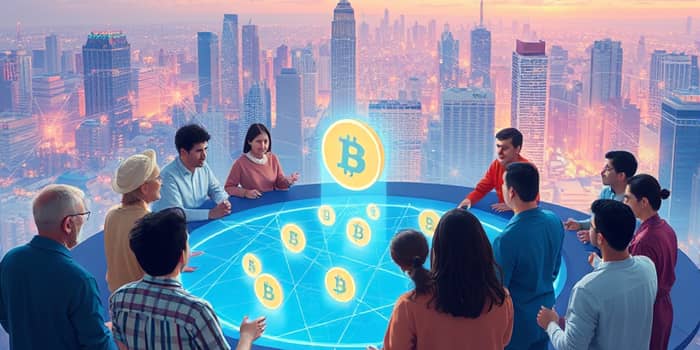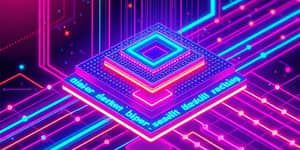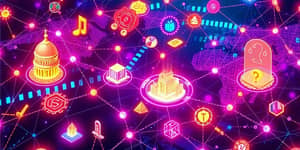In a world seeking new models of collaboration and decision-making, Decentralized Autonomous Organizations (DAOs) have emerged as a revolutionary force. By combining blockchain technology with community-driven governance, DAOs aim to redefine how organizations operate and distribute power.
Definition and Core Concepts
A Decentralized Autonomous Organization is an entity governed by code (smart contracts) and managed collectively by its members on a blockchain. Unlike traditional corporations, DAOs eliminate centralized leadership, enabling stakeholders to propose and vote on initiatives.
- Decentralization: No central authority; control is distributed among members.
- Smart Contracts: Self-executing code on a blockchain automates rules and outcomes.
- Transparency and Trust: Transactions and decisions are transparent and verifiable by anyone.
- Tokenized Ownership: Tokens represent voting rights and stakes in the organization.
- Voting Mechanisms: Community proposals and votes drive strategic direction.
This structure shifts trust from human intermediaries to immutable code, fostering greater accountability.
Historical Context and Evolution
The DAO concept traces back to blockchain’s inception. Bitcoin is often cited as a proto-DAO, but the first major experiment occurred on Ethereum. In 2016, The DAO hack sparked an industry-wide reckoning. The organization had raised over $150 million in Ether before a vulnerability led to a $60 million exploit, ultimately causing the Ethereum Classic split.
Fast-forward to 2021, ConstitutionDAO demonstrated mass coordination by raising nearly $47 million to bid for a historic document. Although outbid, it showcased the potential of global, borderless crowdfunding and community governance.
Technical and Legal Architecture
DAOs rely on a combination of on-chain and off-chain mechanisms. Core functions such as proposal submission, voting, and fund distribution occur via self-executing code on a blockchain. However, real-world tasks—legal compliance, development work, and administrative duties—often require off-chain agreements mediated by entities elected by the DAO.
Legally, DAOs exist in a gray area. Some jurisdictions, like Wyoming and Utah, have introduced frameworks recognizing DAOs as limited liability companies, granting them legal personhood. Yet, regulatory clarity remains a work in progress in most countries.
Governance Models
Governance structures vary widely, each with trade-offs between influence, fairness, and engagement.
- Token-Based Governance: Voting power proportional to tokens held; may favor wealth concentration.
- Reputation-Based Governance: Influence tied to contributions and reputation; aims for meritocracy.
- Hybrid Models: Combine tokens and reputation to balance incentives.
Leading DAOs like ENS DAO and JuiceboxDAO implement nuanced combinations of these models, tailoring voting thresholds and delegation options to their communities.
Applications and Use Cases
DAOs span numerous sectors, transforming how groups collaborate and allocate resources.
- DeFi Protocol Management: MakerDAO and Uniswap coordinate upgrades, risk parameters, and treasury allocations.
- Open-Source Development: Aragon and MolochDAO fund and govern software projects with community-driven roadmaps.
- Art and Collectives: NFT DAOs curate digital galleries and manage shared collections.
- Social DAOs: Groups like Friends with Benefits host events and exclusive content for members.
- Investment DAOs: The LAO and Gitcoin DAO pool funds to back startups and public goods.
DAO Lifecycle and Operations
Establishing a DAO involves several key steps: defining voter eligibility (usually token holders), setting quorum and proposal thresholds, designing proposal templates, choosing on-chain and off-chain tools, and running pilot votes to refine governance. Well-structured proposal mechanisms include clear titles, summaries, implementation details, and voting schedules.
Transparency tools such as public dashboards allow stakeholders to track proposals, voting outcomes, and treasury movements, fostering trust and enabling data-driven decision-making.
Challenges and Risks
Despite their promise, DAOs face significant hurdles. Smart contract vulnerabilities can lead to major security incidents, as seen in 2016. Governance attacks—where large token holders (whales) sway outcomes—can undermine fairness. Voter apathy and collusion further complicate collective decision-making.
Moreover, the legal murkiness around jurisdiction and liability poses challenges for DAOs seeking mainstream adoption. Ensuring compliance while retaining decentralized principles remains an ongoing debate.
Statistics and Adoption
DAO adoption has grown exponentially in recent years, driven by innovation and broader interest in Web3 governance.
DeepDAO reports that by late 2023, cumulative treasury holdings over billions of dollars were managed by thousands of DAOs, with membership numbers often reaching hundreds of thousands.
The Future of DAOs
As DAOs evolve, innovations like quadratic voting and liquid democracy aim to mitigate power imbalances and enhance equitable participation. Interoperability across blockchains and integration with decentralized identity solutions promise more seamless collaboration.
Legal frameworks such as the Wyoming DAO LLC provide a blueprint for marrying code-based governance with regulatory compliance, paving the way for mainstream adoption. Increasing automation of off-chain tasks through oracles and advanced smart contracts will further shift responsibilities onto immutable code.
Conclusion
Decentralized Autonomous Organizations represent a bold experiment in collective governance and organizational design. By leveraging blockchain’s trustless infrastructure, DAOs enable borderless participation and automated governance, challenging traditional corporate structures. While risks and legal uncertainties persist, ongoing technological and regulatory developments are poised to unlock the full potential of DAOs, ushering in a new era of transparent, collaborative decision-making.
References
- https://www.coinbase.com/learn/crypto-basics/what-are-decentralized-autonomous-organizations
- https://pixelplex.io/blog/dao-governance-models/
- https://corporations.utah.gov/2023/12/15/decentralized-autonomous-organization-dao/
- https://www.rapidinnovation.io/post/dao-governance-models-explained-token-based-vs-reputation-based-systems
- https://www.bitlaw.com/blockchain/DAO.html
- https://www.aragon.org/how-to/set-up-your-dao-governance-in-8-steps
- https://www.chainalysis.com/blog/introduction-to-decentralized-autonomous-organizations-daos/
- https://blog.thirdweb.com/what-is-a-dao/










